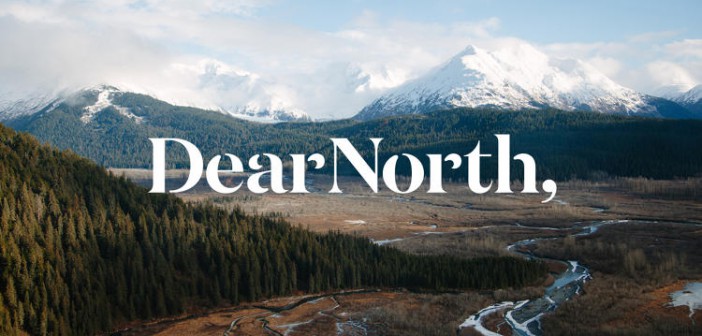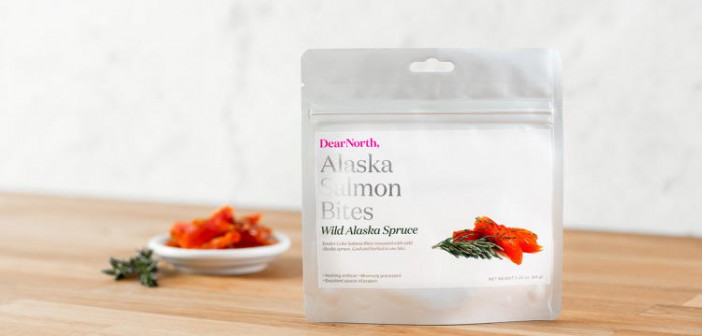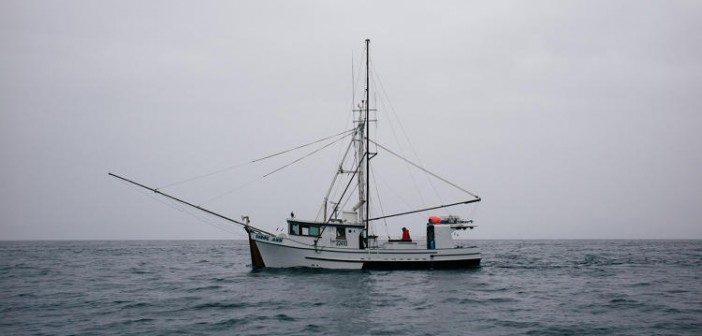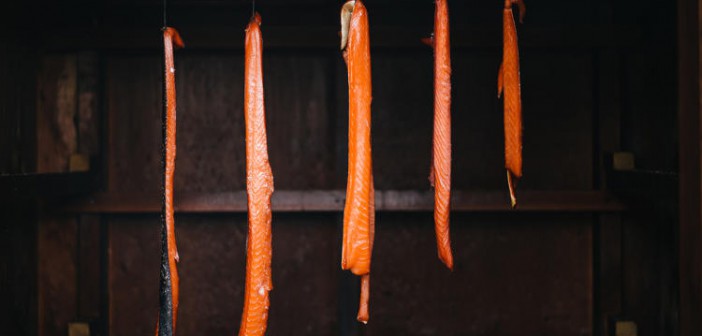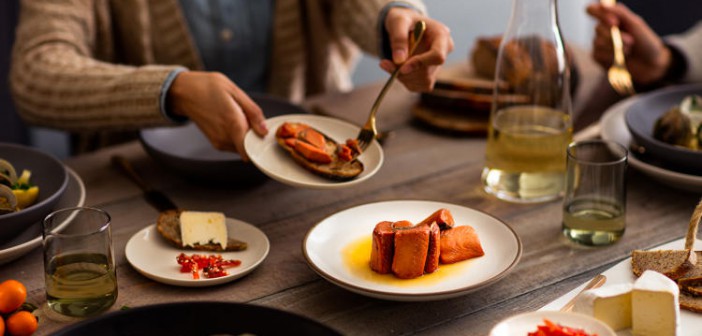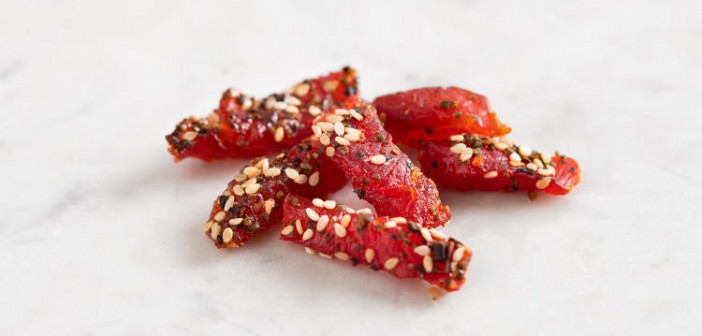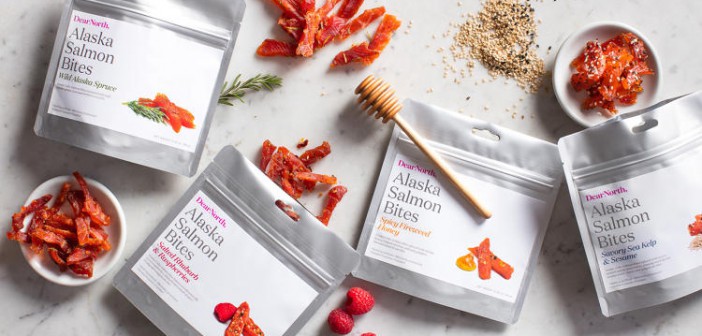Ammunition—a 2016 National Design Award winner—departs from its typical tech work to create a product line for an Alaskan tribe.
The state of Alaska conjures up all kinds of associations. For some, it speaks to endless expanses of untrammeled wilderness; to others it’s Sarah Palin territory. For the Huna Totem tribe—which is located in Juneau, the state’s capital—it represents something deeper.
“From a spiritual perspective, Alaska means all of these direct, uninterrupted, personal sensory experiences,” says Matt Rolandson, a partner at the design firm Ammunition. “The things you feel, the things you see, the things you smell, and that direct uninterrupted experience of letting the visceral part of the place happen to you.”
The San Francisco–based firm, which won a 2016 National Design Award for industrial design work for companies such as Beats and Polaroid, recently built a lifestyle brand for the Huna Totem called Dear North—a dramatic departure from its typical client roster of Silicon Valley startups.
Looking at the packaging and identity system for Dear North shows that Ammunition didn’t stray far from its telltale Apple-esque aesthetic. (Firm cofounder Robert Brunner was director of industrial design at the tech company from 1989 to 1996 and hired Jonathan Ive during his tenure.) The brand‘s salmon snacks come in a metallic bag with minimal graphics, restrained typography, and a clear product image set against a pure white background. Its website is uncluttered and features crisp, close-up photography. Who could have guessed that dried fish would be positioned much like an iPod?
“It was an amazing opportunity to take a break from life in the bubble,” Rolandson says. “I’m from the tech bubble, my whole career has been here, and I was born here. Don’t get me wrong, I love the bubble, but it was this really attractive opportunity to spend time with people and a business that seemed to make perfect sense from a concept perspective. Totally nontechnical, innovative in its own way, but not in a Silicon Valley trend kind of way.”
The project’s scope was pretty traditional—product consulting, packaging, and branding. No apps, technology, or industrial manufacturing. However—typical of Ammunition‘s process—every detail was thought through. “We undertook all the same steps we normally take when we’re trying to develop positioning, messaging, an identity, and a name for an IoT startup,” Rolandson says. “It’s the exact same pattern of thought and activity, only it was kind of an experiment in what happens when you plug that framework into a radically different cultural concept—it still works.”
Dear North recently launched with two products, smoked sockeye salmon and a jerky-like snack, but it’s only the beginning of the company’s aspirations. In Alaska, Native American tribes are considered corporations, a legal framework developed under the Nixon administration intended to promote economic health and sustainability. The Huna Totem tribe—which has about 1,400 members, all of whom are shareholders in the corporation—currently makes money through tourism, marketable securities, and land that it owns, but wanted to diversify its revenue stream.
“There’s something magical about Alaska,” says Anne French, the vice president of marketing and sales at the Huna Totem Corporation and Dear North’s business lead. “We thought, what is it? Could we bottle it? Everyone knows the story of man conquering nature, bears, and the Deadliest Catch, but there’s this other side that’s equally rich, but it’s not as well known and no one’s telling that story.”
French, who comes from a product development background, started with exploratory market research in Seattle, Portland, and San Francisco to help determine consumer profiles for prospective products that the Huna Totem could make or sell. The profile with the most potential was a consumer who is “actively engaged, female, educated, affluent or affluent aspirant, doesn’t trust advertising, reads everything, is interested in ethical issues, and does research, and the defining characteristic is she believes all of her actions make a difference,” French says. “Twenty-five percent of the market fits into this characteristic.”
She was familiar with Ammunition‘s work and thought that while there are great firms for whom branding is their bread and butter, the company needed a design partner that had a more comprehensive approach. “There were a number of things that could go wrong, so having the holistic design partner was crucial,” French says.
After speaking with French and the Huna Totem’s board, Rolandson was intrigued. “I was attracted to their default assumption that you couldn’t have any conversation or make any decision without checking in on your sense of purpose and values,” he says. “With most leadership teams, I kind of force myself to ask, ‘What’s the point of doing this?’ quite a bit. If they have a core set of things that they care about and clearly defined sense of purpose, it’s the thing that tends to make businesses and brands and their products and services special. With these guys, there was no forcing anything. They explained to me that as a tribe everything they do had to be viewed through the purpose and value system of the tribe.”
The tribe had developed a shortlist of product categories they were interested in exploring—food, beauty, and home goods. Ammunition‘s initial steps were to define and visualize how the brand embodies “Alaska.”
While the manifest destiny, wilderness, and exploration were very real themes, they symbolized man coming up against nature. The feeling they were after was living alongside it—a true sense of what it means to be an Alaskan tribe to the Huna Totem. Simultaneously, Ammunition looked at market research to inform what a viable product could be knowing that whatever it was had to have genuine connection to the Huna Totem’s culture and way of life. Working with its team of designers, Ammunition began a design-thinking exercise that involved coming up with 40 to 50 different scenarios of products for the company.
This helped Ammunition come up with the name for the brand. “Dear North, with a comma, shows that the product itself was sort of a love letter to Alaska,” Rolandson says. “Every product they make, every piece of visual communication has to honor and respect this idea of Alaska that they hold dear. From a cultural and a brand guideline perspective, it has a built-in mechanism.”
The inaugural products hold cultural significance to the Huna Totem as salmon is a common food. Jars of smoked salmon are often exchanged as gifts the way bottles of wine might be in the lower 48 states. Since the food—and all of the subsequent products—will have a handmade sensibility, Ammunition opted for a clean, minimal packaging and identity system to amplify the product’s perceived value. The salmon snacks come in a matte silver pouch with a white label emblazoned with the product’s name, a brief description, and a photograph; the smoked salmon comes in a mason jar wrapped in a paper band with minimal copy. Rolandson argues that while Spartan design can sometimes read as cold and unwelcoming, it balances the richness of Dear North’s products.
For Dear North’s marketing materials, Ammunition‘s in-house photographer captured close-up vignettes of people at a table—with a spread of salmon products, naturally—that show how the food could be prepared, shared, and consumed. To complement those images, he also shot aerials of the landscape and super-tight photographs of plants and fish. They all look like they could have easily been plucked from an editorial spread in a lifestyle quarterly. For social media, the firm also created short videos depicting the salmon smoking process, picking fresh berries, gurgling streams, boating across Glacier Bay, and hiking near a glacier, among others. (“It’s not like some B-roll playing behind a bank ad—it’s actually right there, real mountain snow and glaciers,” Rolandson says of visiting the Huna Totem and seeing the landscape as part of the research process.) They’re all intimate moments—the only sound is natural ambient noise—that speak to the notion of being attuned with the landscape.
To Rolandson, what makes a brand successful isn’t that it’s constructed, it’s about visualizing what a company or organization is already about.
“Successful lifestyle brands frankly aren’t lifestyle brands, they’re just real,” he says. “To be honest, the hair on the back of my neck has always stood up whenever I’ve even heard the jargon of ‘lifestyle brand.’ I don’t buy this idea of specifically engineering a reality and value system to create a fantasy world you’re going to invite people to escape into. Obviously, there is a legitimate category called ‘lifestyle brand,’ which is fine, but the ones that succeed creatively, in terms of audience relationships and economically, are the ones where it’s not a contrivance. And that’s why it’s so funny to hear marketing pundits go on and on about the importance of authenticity. Well, no shit. If you want people to feel your thing is real, a safe strategy is being real.”
Ammunition isn’t going to abandon its current direction and start branding lifestyle companies right and left, but building Dear North along with the Huna Totem left an impression on Rolandson. “The whole experience has made me more stubborn in my belief that the company’s own ideology is a big part of how you make decisions about design,” he says. “I feel more strongly about that than ever.”
The firm will continue to work with Dear North as it expands its offerings. While the product road map is still in the concept stages, French says products such as blankets, satchels, and tabletop items might be on the horizon. The current merchandise is available on Dear North’s website and in some specialty stores, and the company just entered into a distribution deal with Ralph’s and Raley’s on the West Coast.
All Images: courtesy Ammunition

